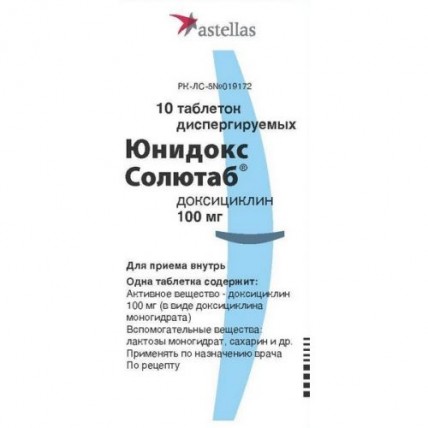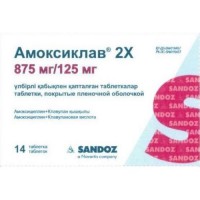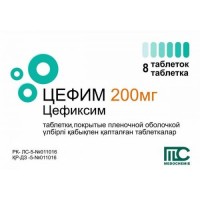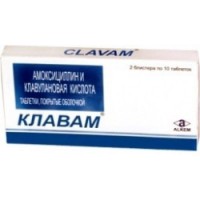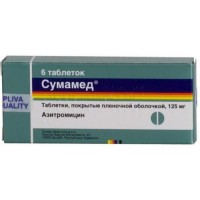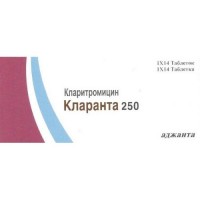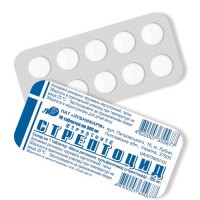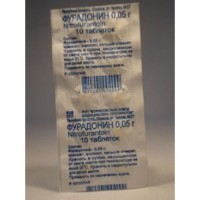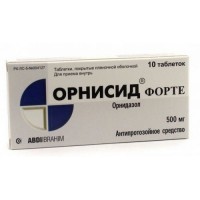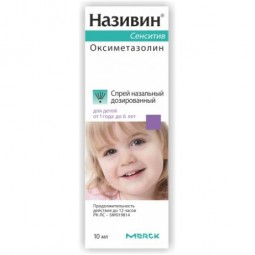JUnidoks Soljutab 10s dispersing 100 mg tablets
- $18.50
The instruction for medical use of Solyutab® Unidoks medicine the Trade name of Unidoks Solyutab® the International unlicensed name Doxycycline Dosage Form of the Tablet dispersed, 100 mg One tablet contains Structure: active agent – doxycycline of 100 mg (in the form of monohydrate doxycycline) excipients: microcrystalline cellulose, saccharin, a hypro rod (in small quantity), a gipromelloza, silicon dioxide colloidal anhydrous, magnesium stearate, lactoses monohydrate. The description Round, biconvex tablets from light yellow color or gray-yellow color to brown with impregnations, with an engraving 173 on one party and risky on another Pharmacotherapeutic group Anti-infectious drugs for system use. Antibacterial drugs for system use. Tetracyclines. Doxycycline. The ATX J01AA02 code the Pharmacological Pharmacokinetics Absorption Docsitsiklin properties is almost completely soaked up after intake. Intake of food or milk significantly does not influence doxycycline absorption. Concentration of doxycycline of 1.5-3 mg/l in blood plasma is reached at use of a usual dose of 200 mg in the first day and then 100 mg a day. Average values of the maximum concentration in blood plasma of 2.6-3.0 mg/l, are noted in 2 hours after intake of doxycycline, in 24 hours the concentration decreases approximately to 1.5 mg/l. Distribution Linking of doxycycline with proteins makes about 90%. The volume of distribution is 1.6 l/kg. Doxycycline easily gets into fabrics and it is bad – through a blood-brain barrier. Concentration in cerebrospinal fluid increases at inflammation of meningeal covers. Doxycycline collects in jaws and bones (including fruit fabrics). Doxycycline gets through a placental barrier and is emitted with breast milk of the person. Concentration of doxycycline in fruit blood approximately by 0.3 times exceeds concentration in mother's blood. Concentration of doxycycline in amniotic liquid approximately by 0.3 times exceeds concentration in mother's blood. Concentration of doxycycline in breast milk at the person makes 30-40% of serumal concentration. Metabolism the Main ways of metabolism of doxycycline are not revealed, however inductors of enzymes reduce elimination half-life of doxycycline. Removal Elimination half-life of doxycycline makes about 20 hours of blood plasma. More than 40% of the soaked-up dose of doxycycline are removed by kidneys by glomerular filtration. Doxycycline is also removed with a stake where forms an inactive complex. Only a small part of a dose of doxycycline is removed with bile, however its concentration in bile, as a rule, at 5-10 times exceeds concentration in blood plasma. Pharmacokinetics in special groups of patients the Patients with an abnormal liver function Pharmacokinetic data for patients with an abnormal liver function are absent. Patients with a renal failure the doxycycline Removal by kidneys makes about 40% / 72 hours at persons with normal function of kidneys. It can be reduced to 1-5% / 72 hours at persons with a heavy renal failure (clearance of creatinine less than 10 ml/min.). In researches the lack of significant differences in elimination half-life of doxycycline from blood plasma at persons with normal function of kidneys and at persons with a heavy renal failure as reduced removal by kidneys is compensated by the strengthened removal with a stake was shown. The hemodialysis does not influence elimination half-life of doxycycline. A pharmacodynamics the Antibiotic of a broad spectrum of activity from group of tetracyclines. Works bacteriostatically, suppresses synthesis of protein in a microbic cell by interaction with 30S a subunit of ribosomes. The resistance of microorganisms, as a rule, is mediated by plasmids or transposons. The main mechanism of resistance is connected with the strengthened removal of tetracyclines from a bacterial cell. Significant local differences among resistant strains among species of microorganisms with natural sensitivity are possible. Some strains of Streptococcus pyogenes, Streptococcus pneumoniae and Enterococcus faecalis of a rezistentna to tetracyclines. Therefore tetracyclines should not be applied in streptococcal infections before confirmation of sensitivity of bacteria to them. In the upper respiratory tract infections caused by a beta and hemolytic streptococcus of group A (including for prevention of acute arthritis) other medicines are shown. Among antibiotics of group of tetracyclines the cross resistance is characteristic. Available data of clinical performance of doxycycline in treatment of anthrax at the person are insufficient. It is necessary to address the existing national and/or international recommendations about treatment of anthrax. Available data of clinical performance of doxycycline in therapy of the plague (caused by Yersinia pestis) and the tularemia (caused by Francisella tularensis) at the person are insufficient. It is necessary to address the existing national and/or international recommendations about treatment of plague and a tularemia. Indications Doxycycline showed efficiency in treatment of various infections caused by sensitive strains of gram-positive and gram-negative bacteria and some other microorganisms. Respiratory infections. The pneumonia and other lower respiratory tract infections caused by sensitive strains of Streptococcus pneumoniae, Haemophilus influenzae, Klebsiella pneumoniae and other microorganisms. The pneumonia caused by Mycoplasma pneumoniae. Chronic bronchitis, sinusitis. Infections of an urinogenital system. The infections caused by sensitive strains of Klebsiella spp., Enterobacter spp., Escherichia coli, Streptococcus faecalis and other microorganisms. Diseases, sexually transmitted. The diseases caused by Chlamydia trachomatis including an uncomplicated urethral, endocervical or rectal infection. Not gonococcal urethritis, the caused Ureaplasma urealyticum (T-mycoplasma). Doxycycline is also shown to use at a shankroid (venereal ulcer), an inguinal granuloma and a venereal lymphogranuloma. Doxycycline is alternative medicine in treatment of gonorrhea and syphilis. Skin infections. An acne disease (acne vulgaris) if therapy is shown by antibiotics. Doxycycline can be effective in therapy of the infections which are well responding to treatment by other tetracyclines, such as: The eye infections caused by sensitive gonokokka, streptococci, stafilokokka and Haemophilus influenzae. Trachoma though, according to an immunofluorescence, it is not always possible to reach elimination of the infectious agent. Therapy of conjunctivitis with inclusions can be performed by oral administration of doxycycline or in a combination with means of local action. Rickettsial diseases. Spotty fever of the Rocky Mountains, typhus, Q fever, koksiyellezny endocarditis and tick-borne fever. Other infections. Ornithosis, a brucellosis (in combination with streptomycin), cholera, bubonic plague, an endemic and epidemic typhinia, a tularemia, a melioidosis, chlorokhinoustoychivy tropical malaria and a sharp intestinal amebiasis (as supportive application to amebotsidny medicine). Doxycycline is alternative medicine in treatment of leptospirosis, gas gangrene and tetanus. Doxycycline is shown in the preventive purposes at the following states: tsutsugamusha fever (Japanese river fever), the diarrhea of travelers (caused by enterotoxigenic Escherichia coli), leptospirosis and malaria. Doxycycline is applied to prevention of malaria according to the acting managements in view of existence of change of resistance of the activator. The route of administration and doses the Dispersed tablets are intended only for oral administration. Add a tablet to a glass of water and well mix before uniform hashing (at least 50 ml). Accept mix immediately. Reception is carried out in a sitting position or standing long before a dream for reduction of risk of emergence of irritation of a gullet and appearance of ulcers. In case of irritation of a stomach, doxycycline is recommended to be accepted with food or milk. Absorption of doxycycline had no considerable impact on simultaneous digestion of food and milk. When exceeding the recommended dosage the frequency of emergence of side effects can increase. It is necessary to continue therapy, at least, 24-48 hours after disappearance of symptoms and temperature. Treatment of streptococcal infections should be carried out within 10 days in order to avoid development of rheumatism and a glomerulonephritis. Adult patients and children aged from 12 up to 18 years the Standard dose of doxycycline for treatment of acute infections at adults makes 200 mg in the first day (in 1 – 2 reception) then the maintenance dose makes 100 mg a day. In case of heavy infections doxycycline appoint in a dose 200 mg a day throughout all course of therapy. Children aged from 8 years up to 12 years. Use of doxycycline for treatment of acute infections at children aged from 8 up to 12 years has to be carefully proved in situations when other drugs are absent, will hardly be effective or are contraindicated. The recommended dosing mode at children at the age of 8 years or is more senior and with body weight less than 45 kg make 4 mg/kg of body weight (apply once in one step) in the first day of therapy, then in the next days 2 mg/kg of body weight (in one step). Doses up to 4 mg/kg of body weight a day can be applied in heavy infections throughout all treatment. The dose less than 100 mg (a maintenance dose at children with body weight less than 45 kg) cannot be received at use of the drug Unidoks Solyutab®. For this purpose use other medicines containing doxycycline. Children with body weight more than 45 kg, have to receive drug in a dose for adults. The recommended doses for treatment of some diseases: The acne disease (acne vulgaris) - 50 mg a day during meal or to liquid is 6-12 weeks. Infections, sexually transmitted: - uncomplicated gonococcal infections (except for an anorectal infection at men), an uncomplicated urethral, endocervical or rectal infection, vyzyvanny Chlamydia trachomatis, not gonococcal urethritis, vyzyvanny Ureaplasma urealyticum. The dose of doxycycline of 100 mg 2 times a day 7 days is recommended. - sharp epididimoorkhit, the caused Chlamydia trachomatis or Neisseria gonorrhea – 100 mg two times a day within 10 days. - primary and secondary syphilis: possible schemes of treatment for non-pregnant patients with an allergy to penicillin - 200 mg twice a day within two weeks, in the form of a therapy alternative penicillin. Primary and secondary syphilis of 200 mg a day within not less than 14 days. A venereal lymphogranuloma (Lymphogranuloma venereum (LGV)) of 200 mg within 21 days. The diseases caused by microorganisms of the sort Borrelia (borreliosis) of 200 mg a day within 10-21 days (early stage of a disease) and up to 1 month in cases of later manifestations. An endemic and epidemic typhinia - a single dose of 100 or 200 mg depending on severity. Treatment of chlorokhinoustoychivy tropical malaria - adults: 200 mg a day within, at least, 7 days. - children are more senior than 8 years: 2.2 mg/kg two times a day within not less than 7 days (to a dose of 200 mg/days). In view of potential weight of a course of the disease together with doxycycline it is necessary to accept shizontotsidny antimalarial means, for example, quinine. Prevention of malaria - 100 mg a day for adults and children is more senior than 12 years. Prevention can be begun in 1-2 days prior to departure to malarial areas. The drug should be taken daily during all term of stay in malarial areas and within 4 weeks after departure. Anthrax: - post-contact prevention: 100 mg two times a day within 60 days - a skin form of anthrax: 100 mg two times a day within 60 days - a pulmonary / gastrointestinal form of anthrax: originally 100 mg two times a day as a part of combination therapy, the general duration of treatment are 60 days. Prevention of fever of a tsutsugamusha - 200 mg once. Prevention of diarrhea of travelers at adults - 200 mg in the first day of a travel (once or on 100 mg each 12 hours), then daily on 100 mg during all term of stay in the respective region. There are no data on use of drug in the preventive purposes more than 21 day. Prevention of leptospirosis - 200 mg once a week during all term of stay in the respective region and 200 mg after completion of a travel. There are no data on use of drug in the preventive purposes more than 21 day. Spotty fever of the Rocky Mountains Adults: To 100 mg there are each 12 hours. Children with body weight less than 45 kg: 2.2 mg/kg of body weight, twice a day. Children weighing 45 kg or more it is necessary to receive a dose for adults. Patsiyentov it is necessary to treat not less than 3 days after body temperature decreases and proofs of clinical improvement will not appear. Minimum course of treatment of 5-7 days. Use for adult patients Docsitsiklin can be appointed to adult patients in a standard dose without any special precautionary measures. In a renal failure the dose adjustment is not required. The dispersed tablets Unidoks Solyutab® can be a preferable dosage form for elderly patients as they lead to emergence of irritation of a gullet and appearance of ulcers less often. Side effects Undesirable effects are listed below according to system and organ classification of MeDRA and by emergence frequency. Emergence frequency: often (≥1/100, & lt, 1/10), infrequently (≥1/1,000, & lt, 1/100), it is rare (≥1/10,000, & lt, 1/1,000). At the patients receiving tetracyclines the following side effects were noted: Infectious and parasitic diseases Often: vaginitis, candidiasis. Narusheniya from blood and lymphatic system Seldom: hemolytic anemia, thrombocytopenia, neutropenia, eosinophilia. It is unknown: increase in a prothrombin time. Narusheniya from the immune system Seldom: medicinal reaction with an eosinophilia and system symptoms (DRESS). Very seldom: reactions of hypersensitivity (including, acute anaphylaxis, anaphylaxis, anaphylactoid reaction, anaphylactoid purpura, hypotension, pericarditis, Quincke's disease, aggravation of a system lupus erythematosus, asthma, serum disease, peripheral hypostases, tachycardia and small tortoiseshell). It is unknown: Yarisha-Gerksgeymer Narusheniya's reaction from an endocrine system Seldom: a dark brown prokrashivaniye of tissue of thyroid gland (during prolonged use). Narusheniya from a metabolism and food it is rare: anorexia. It is unknown: porphyria. Narusheniya from nervous system Infrequently: headache. Very seldom: protrusion of a fontanel, symptoms of irritation of a meninx with a papilledema (illegibilities of sight, doubling in eyes, nausea, vomitings, a ring in ears, dizzinesses, retrobulbar pain and a photopsia can be followed by symptoms in the form of a headache). Narusheniya from an organ of hearing and balance it is rare: a ring in ears. Disturbance from heart Is rare: pericarditis. It is unknown: tachycardia. Narusheniya from vessels Seldom: inflows. Disturbance from digestive tract Is frequent: nausea, an itching in an anus, blackening of language, stomatitis, inflammation in anogenitalny area. Infrequently: vomiting, diarrhea, glossitis. Seldom: an abdominal pain, a dysphagy, dyspepsia, a coloenteritis (including, staphylococcal enteritis), pancreatitis, suppression of growth of the bacteria producing group B vitamins. Very seldom: pseudomembranous colitis (with the excess growth of Clostridium difficile). It is unknown: esophagitis, gullet ulcers. Narusheniya from a liver and biliary tract it is rare: an abnormal liver function, hepatotoxicity with tranzitorny increase in activity of liver enzymes, hepatitis, jaundice, a liver failure. Narusheniya from skin and hypodermic fabrics Infrequently: makulopapulezny and erythematic rash, photosensitivity. Seldom: Stephens-Johnson's syndrome, toxic epidermal necrolysis, small tortoiseshell, exfoliative dermatitis. It is unknown: fotoonikholizis (a nail otkhozhdeniye from a nail bed which sometimes leads to full peeling of a nail plate, after influence of sunshine). Disturbances from a musculoskeletal system Often: disturbance of development of a bone tissue. Seldom: arthralgia, myalgia. Disturbances from kidneys and urinary tract it is rare: increase in level of urea in blood. About
shchy disorders and disturbances in the injection site it is frequent: disturbance of development of teeth, irreversible discoloration of teeth, irritation of skin. It is unknown: hypoplasia of adamantine substance of tooth. The message about undesirable medicinal reactions the Message about undesirable medicinal reactions after registration of medicine is extremely important. It gives the chance to continue monitoring of a ratio advantage/risk of medicine. Experts of health care should report about any undesirable medicinal reaction, using the contact information provided below. Contraindications - hypersensitivity to doxycycline or to any of drug excipients, - hypersensitivity to other tetracyclines, - children's age up to 8 years, - pregnancy and the period of a lactation, - hereditary intolerance of fructose, deficiency of Lapp-lactoses enzyme, glucose galactose malabsorption. Medicinal interactions Absorption of doxycycline can worsen at a concomitant use of the antacids containing aluminum, calcium, magnesium or other drugs containing the specified cations, the oral medicines containing zinc, salts of iron and bismuth. Between intake of these drugs there has to pass the greatest possible amount of time. In view of the fact that doxycycline can break bactericidal effect of penicillin, it is recommended to avoid their joint reception. It was reported about increase in a prothrombin time at the patients accepting warfarin and doxycycline. Tetracyclines reduce activity of a prothrombin in blood plasma, at the same time the dose decline of anticoagulants in case of their joint reception can be required. Elimination half-life of doxycycline in blood serum can decrease at a concomitant use patients of barbiturates, carbamazepine or Phenytoinum. It is necessary to consider the possibility of increase in a daily dose of Solyutab® Unidoks medicine. Alcohol can lead to decrease in elimination half-life of doxycycline. It was reported about several cases of pregnancy or intermenstrual bleeding at joint reception of tetracycline antibiotics and oral contraceptives. Doxycycline can increase concentration of cyclosporine in blood plasma. Joint reception demands necessary monitoring. It was reported about lethal cases at joint intake of tetracyclines and a metoksiflurana in view of nephrotoxicity. It is necessary to avoid joint reception of an izotretinoin or other system retinoids and doxycycline. Each of the specified drugs at its use separately led to development of idiopathic intracranial hypertensia (pseudotumor cerebri). Interactions in laboratory researches the false increase in concentration of catecholamines in urine as a result of interaction with flyuorestseiny Can be observed. Special instructions Use for children Doxycycline is contraindicated to use for children aged up to 8 years as it can become the reason of continuous discoloration of teeth (yellow-gray-brown) and cause a hypoplasia of enamel of teeth. As well as in a case with other tetracyclines, doxycycline forms stable calcic complexes in any osteogenic fabric. Use of doxycycline at children is aged younger than 8 years it is allowed only if it is expected that the potential advantage perevyshat possible risks, at serious or life-threatening conditions (for example, spotty fever of the Rocky Mountains), only in case all other options of therapy are inefficient or contraindicated. Solyutab® Unidoks Medicine patients should appoint use for patients with abnormal liver functions with care with a liver failure or to the patients taking the drugs with potential hepatotoxic effect. It was reported about an abnormal liver function after oral and parenteral administration of tetracyclines, including doxycycline. Use for patients with a renal failure doxycycline removal Volume kidneys makes about 40% in 72 hours at persons with normal function of kidneys. This percent of removal can decrease to 1-5% in 72 hours at persons with a heavy renal failure (the clearance of creatinine is lower than 10 ml/min.). In researches significant differences in values of elimination half-life of doxycycline at persons with normal function of kidneys and faces with a heavy renal failure are not revealed. The hemodialysis did not lead to changes of value of elimination half-life of doxycycline. Anti-anabolic effect of tetracyclines can lead to increase in concentration of urea in blood. In researches the lack of anti-anabolic action at patients with impaired renal function at intake of Solyutab® Unidoks medicine is shown. Photosensitivity At some patients accepting tetracyclines, including doxycycline cases of photosensitivity which was shown in the form of a heavy burn as a result of influence of sunshine were observed. Patients who can be affected by direct sunlight or ultraviolet have to be warned about such reaction at intake of tetracyclines, and treatment should be stopped at emergence of the first signs of an erythema of skin. Idiopathic intracranial hypertensia It was reported about cases of protrusion of a fontanel at the newborns accepting tetracyclines. Developing of idiopathic intracranial hypertensia (pseudotumor cerebri) is connected with intake of tetracyclines, including doxycycline. Idiopathic intracranial hypertensia (pseudotumor cerebri), as a rule, is temporary, nevertheless, was reported about cases of the continuous loss of sight caused by intracranial hypertensia at intake of tetracyclines, including doxycycline. When developing a disorder of vision during treatment, it is recommended to undergo ophthalmologic inspection immediately. In view of the fact that intracranial hypertensia can remain up to several weeks after the termination of administration of drug, patients have to be under observation before stabilization of their state. Overgrowth of microorganisms can sometimes lead Intake of doxycycline to the overgrowth of insensitive microorganisms, including sort Candida mushrooms. At emergence of resistant microorganisms reception of this antibiotic it is necessary to stop and correct therapy. It was reported about development of pseudomembranous colitis at intake practically of all antibacterial drugs including the doxycycline different in severity: from easy to zhizneugrozhayushchy. This diagnosis should be considered at patients with the diarrhea arising directly after intake of antibacterial drugs. Clostridium difficile-associated diarrhea (CD-AD). It was reported about development of this disease at intake practically of all antibacterial drugs including doxycycline, with various degrees of severity: from easy to colitis with a lethal outcome. Treatment by antibacterial drugs leads to disappearance of normal flora of intestines and overgrowth of C. difficile. C. difficile produce toxins A and B which contribute to the development of CD-AD. The strains of C. difficile producing hyper toxin can increase the frequency of incidence and mortality as these infections can be resistant to antimicrobic therapy, and removal of colectomy can be required. CD-AD should be taken into account at all patients with the diarrhea arising directly after reception of antibiotics. It is required to keep carefully the medical record as CD-AD can arise more than in two months after the end of antibacterial therapy. Esophagitis It was reported about cases of development of an esophagitis and appearance of ulcers of a gullet in the patients taking the tetracycline drugs including doxycycline, in the form of capsules or tablets. The most part from such patients took the drugs just before a dream or with insufficient amount of liquid. A porphyria It was reported about exceptional cases of development of a porphyria in the patients receiving tetracyclines. Venereal diseases At treatment of venereal diseases with suspicion on presence of the accompanying syphilis it is necessary to apply necessary diagnostic methods, including microscopy in the dark field. In all such cases it is necessary to conduct a serological research not less than four months in a row. The infections caused by beta and hemolytic streptococci Duration of therapy of the infections caused by beta and hemolytic streptococci has to make not less than 10 days. A myasthenia gravis Considering risk of development of weak neuromuscular blockade, it is necessary to show care when prescribing tetracyclines to patients with a myasthenia gravis. The System Lupus Erythematosus (SLE) Tetracyclines can cause aggravation of hard currency. Diabetes 1 tablet of the drug Unidoks Solyutab® contains 0.064 g of lactose of monohydrate. It is necessary to appoint drug with care sick diabetes. At some patients with the infectious diseases caused by pathogenic spirochetes soon after the beginning of use of doxycycline Yarisha-Gerksgeymer's reaction can develop. Patients need to be calmed that emergence of this reaction is a consequence of antibiotic treatment of the specified infectious diseases, and as a rule, manifestations of this reaction disappear spontaneously. Pregnancy and the period of breastfeeding of Unidoks Solyutab® it is contraindicated at pregnancy. It is considered that the risks connected with intake of tetracyclines during pregnancy are expressed, mainly, by influence on development of teeth and a skeleton of a fruit. Tetracyclines are emitted in breast milk, therefore, they are contraindicated when breastfeeding. Features of influence of medicine on ability to run vehicles or potentially dangerous mechanisms Influence of doxycycline on ability to run the vehicle is not studied. Overdose Symptoms: the acute overdose by antibiotics meets extremely seldom. In case of overdose the administration of drug should be stopped. Treatment: It is necessary to wash out a stomach and to accept the corresponding therapy. The form of release and packing On 10 tablets place in blister strip packaging from a film of polyvinylchloride and aluminum foil. On 1 blister strip packaging together with the instruction for medical use in the state and Russian languages place in a pack cardboard. To Store storage conditions at a temperature not over 25º C. To store out of children's reach! Period of storage of 5 years. Not to apply after an expiration date. Prescription status According to the prescription. The CJSC ZiO-Zdorove producer, Zheleznodorozhnaya St., 2, Podolsk, Moscow region, 142103, Russian Federation the Holder of the registration certificate Astellas Pharm B.V. Europe, Silviusveg 62, 2333 VE, Leiden, Netherlands the Name, the address and a contact information (phone, the fax, e-mail) of the organization in the territory of the Republic of Kazakhstan, the accepting claim (offer) on quality of medicines from consumers and responsible for post-registration observation of safety of medicine of Astellas Pharm LLP 050059, Republic of Kazakhstan, Almaty, Al-Farabi Ave. 15, the Centre Party of Finland of Nurla Tau, body 4B, office No. 19-4B-10 Phone number / fax +7727 31113/88/89/90 Pharmacovigilance.KZ@astellas.com
to Deploy
shchy disorders and disturbances in the injection site it is frequent: disturbance of development of teeth, irreversible discoloration of teeth, irritation of skin. It is unknown: hypoplasia of adamantine substance of tooth. The message about undesirable medicinal reactions the Message about undesirable medicinal reactions after registration of medicine is extremely important. It gives the chance to continue monitoring of a ratio advantage/risk of medicine. Experts of health care should report about any undesirable medicinal reaction, using the contact information provided below. Contraindications - hypersensitivity to doxycycline or to any of drug excipients, - hypersensitivity to other tetracyclines, - children's age up to 8 years, - pregnancy and the period of a lactation, - hereditary intolerance of fructose, deficiency of Lapp-lactoses enzyme, glucose galactose malabsorption. Medicinal interactions Absorption of doxycycline can worsen at a concomitant use of the antacids containing aluminum, calcium, magnesium or other drugs containing the specified cations, the oral medicines containing zinc, salts of iron and bismuth. Between intake of these drugs there has to pass the greatest possible amount of time. In view of the fact that doxycycline can break bactericidal effect of penicillin, it is recommended to avoid their joint reception. It was reported about increase in a prothrombin time at the patients accepting warfarin and doxycycline. Tetracyclines reduce activity of a prothrombin in blood plasma, at the same time the dose decline of anticoagulants in case of their joint reception can be required. Elimination half-life of doxycycline in blood serum can decrease at a concomitant use patients of barbiturates, carbamazepine or Phenytoinum. It is necessary to consider the possibility of increase in a daily dose of Solyutab® Unidoks medicine. Alcohol can lead to decrease in elimination half-life of doxycycline. It was reported about several cases of pregnancy or intermenstrual bleeding at joint reception of tetracycline antibiotics and oral contraceptives. Doxycycline can increase concentration of cyclosporine in blood plasma. Joint reception demands necessary monitoring. It was reported about lethal cases at joint intake of tetracyclines and a metoksiflurana in view of nephrotoxicity. It is necessary to avoid joint reception of an izotretinoin or other system retinoids and doxycycline. Each of the specified drugs at its use separately led to development of idiopathic intracranial hypertensia (pseudotumor cerebri). Interactions in laboratory researches the false increase in concentration of catecholamines in urine as a result of interaction with flyuorestseiny Can be observed. Special instructions Use for children Doxycycline is contraindicated to use for children aged up to 8 years as it can become the reason of continuous discoloration of teeth (yellow-gray-brown) and cause a hypoplasia of enamel of teeth. As well as in a case with other tetracyclines, doxycycline forms stable calcic complexes in any osteogenic fabric. Use of doxycycline at children is aged younger than 8 years it is allowed only if it is expected that the potential advantage perevyshat possible risks, at serious or life-threatening conditions (for example, spotty fever of the Rocky Mountains), only in case all other options of therapy are inefficient or contraindicated. Solyutab® Unidoks Medicine patients should appoint use for patients with abnormal liver functions with care with a liver failure or to the patients taking the drugs with potential hepatotoxic effect. It was reported about an abnormal liver function after oral and parenteral administration of tetracyclines, including doxycycline. Use for patients with a renal failure doxycycline removal Volume kidneys makes about 40% in 72 hours at persons with normal function of kidneys. This percent of removal can decrease to 1-5% in 72 hours at persons with a heavy renal failure (the clearance of creatinine is lower than 10 ml/min.). In researches significant differences in values of elimination half-life of doxycycline at persons with normal function of kidneys and faces with a heavy renal failure are not revealed. The hemodialysis did not lead to changes of value of elimination half-life of doxycycline. Anti-anabolic effect of tetracyclines can lead to increase in concentration of urea in blood. In researches the lack of anti-anabolic action at patients with impaired renal function at intake of Solyutab® Unidoks medicine is shown. Photosensitivity At some patients accepting tetracyclines, including doxycycline cases of photosensitivity which was shown in the form of a heavy burn as a result of influence of sunshine were observed. Patients who can be affected by direct sunlight or ultraviolet have to be warned about such reaction at intake of tetracyclines, and treatment should be stopped at emergence of the first signs of an erythema of skin. Idiopathic intracranial hypertensia It was reported about cases of protrusion of a fontanel at the newborns accepting tetracyclines. Developing of idiopathic intracranial hypertensia (pseudotumor cerebri) is connected with intake of tetracyclines, including doxycycline. Idiopathic intracranial hypertensia (pseudotumor cerebri), as a rule, is temporary, nevertheless, was reported about cases of the continuous loss of sight caused by intracranial hypertensia at intake of tetracyclines, including doxycycline. When developing a disorder of vision during treatment, it is recommended to undergo ophthalmologic inspection immediately. In view of the fact that intracranial hypertensia can remain up to several weeks after the termination of administration of drug, patients have to be under observation before stabilization of their state. Overgrowth of microorganisms can sometimes lead Intake of doxycycline to the overgrowth of insensitive microorganisms, including sort Candida mushrooms. At emergence of resistant microorganisms reception of this antibiotic it is necessary to stop and correct therapy. It was reported about development of pseudomembranous colitis at intake practically of all antibacterial drugs including the doxycycline different in severity: from easy to zhizneugrozhayushchy. This diagnosis should be considered at patients with the diarrhea arising directly after intake of antibacterial drugs. Clostridium difficile-associated diarrhea (CD-AD). It was reported about development of this disease at intake practically of all antibacterial drugs including doxycycline, with various degrees of severity: from easy to colitis with a lethal outcome. Treatment by antibacterial drugs leads to disappearance of normal flora of intestines and overgrowth of C. difficile. C. difficile produce toxins A and B which contribute to the development of CD-AD. The strains of C. difficile producing hyper toxin can increase the frequency of incidence and mortality as these infections can be resistant to antimicrobic therapy, and removal of colectomy can be required. CD-AD should be taken into account at all patients with the diarrhea arising directly after reception of antibiotics. It is required to keep carefully the medical record as CD-AD can arise more than in two months after the end of antibacterial therapy. Esophagitis It was reported about cases of development of an esophagitis and appearance of ulcers of a gullet in the patients taking the tetracycline drugs including doxycycline, in the form of capsules or tablets. The most part from such patients took the drugs just before a dream or with insufficient amount of liquid. A porphyria It was reported about exceptional cases of development of a porphyria in the patients receiving tetracyclines. Venereal diseases At treatment of venereal diseases with suspicion on presence of the accompanying syphilis it is necessary to apply necessary diagnostic methods, including microscopy in the dark field. In all such cases it is necessary to conduct a serological research not less than four months in a row. The infections caused by beta and hemolytic streptococci Duration of therapy of the infections caused by beta and hemolytic streptococci has to make not less than 10 days. A myasthenia gravis Considering risk of development of weak neuromuscular blockade, it is necessary to show care when prescribing tetracyclines to patients with a myasthenia gravis. The System Lupus Erythematosus (SLE) Tetracyclines can cause aggravation of hard currency. Diabetes 1 tablet of the drug Unidoks Solyutab® contains 0.064 g of lactose of monohydrate. It is necessary to appoint drug with care sick diabetes. At some patients with the infectious diseases caused by pathogenic spirochetes soon after the beginning of use of doxycycline Yarisha-Gerksgeymer's reaction can develop. Patients need to be calmed that emergence of this reaction is a consequence of antibiotic treatment of the specified infectious diseases, and as a rule, manifestations of this reaction disappear spontaneously. Pregnancy and the period of breastfeeding of Unidoks Solyutab® it is contraindicated at pregnancy. It is considered that the risks connected with intake of tetracyclines during pregnancy are expressed, mainly, by influence on development of teeth and a skeleton of a fruit. Tetracyclines are emitted in breast milk, therefore, they are contraindicated when breastfeeding. Features of influence of medicine on ability to run vehicles or potentially dangerous mechanisms Influence of doxycycline on ability to run the vehicle is not studied. Overdose Symptoms: the acute overdose by antibiotics meets extremely seldom. In case of overdose the administration of drug should be stopped. Treatment: It is necessary to wash out a stomach and to accept the corresponding therapy. The form of release and packing On 10 tablets place in blister strip packaging from a film of polyvinylchloride and aluminum foil. On 1 blister strip packaging together with the instruction for medical use in the state and Russian languages place in a pack cardboard. To Store storage conditions at a temperature not over 25º C. To store out of children's reach! Period of storage of 5 years. Not to apply after an expiration date. Prescription status According to the prescription. The CJSC ZiO-Zdorove producer, Zheleznodorozhnaya St., 2, Podolsk, Moscow region, 142103, Russian Federation the Holder of the registration certificate Astellas Pharm B.V. Europe, Silviusveg 62, 2333 VE, Leiden, Netherlands the Name, the address and a contact information (phone, the fax, e-mail) of the organization in the territory of the Republic of Kazakhstan, the accepting claim (offer) on quality of medicines from consumers and responsible for post-registration observation of safety of medicine of Astellas Pharm LLP 050059, Republic of Kazakhstan, Almaty, Al-Farabi Ave. 15, the Centre Party of Finland of Nurla Tau, body 4B, office No. 19-4B-10 Phone number / fax +7727 31113/88/89/90 Pharmacovigilance.KZ@astellas.com
to Deploy
